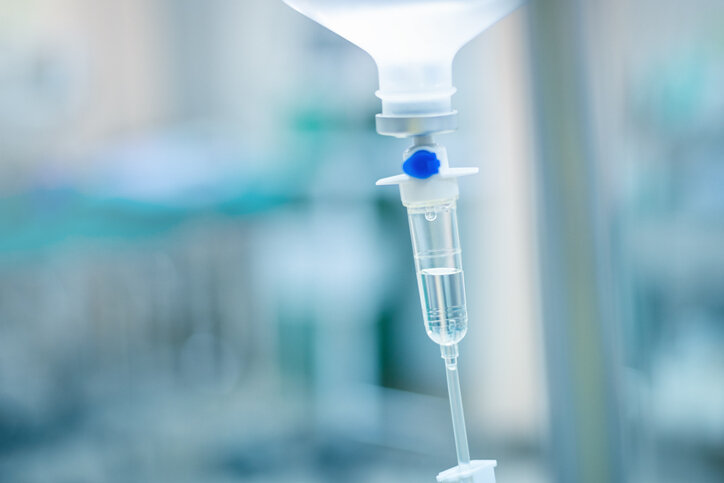The Use of Traditional Chemotherapy in Lung Cancer
Many of us are on a tyrosine kinase inhibitor (TKI), however there are definite benefits to the use of traditional chemotherapy (chemo). In this article, we will learn a little more about this treatment option.
Chemo may be recommended by your doctor in different situations:
In stages I-III only:
Before surgery (neoadjuvant chemotherapy): Neoadjuvant chemo may be used (sometimes in combination with radiation therapy) to try to shrink a tumor to remove it with less extensive surgery.
After surgery (adjuvant chemotherapy): Adjuvant chemo may be used (sometimes in combination with radiation therapy) to attempt to destroy any cancer cells that might have remained or have spread, but can't be seen on imaging tests.
For locally advanced NSCLC (anytime): Sometimes, chemo along with radiation therapy is given as the main treatment for more advanced cancers that have grown into nearby structures if surgery is not an option or for people who aren’t healthy enough for surgery.
For metastatic NSCLC (stage IV): Chemo may be given for lung cancer that has spread to areas outside the lung such as the bones, liver, or adrenal gland.
Chemo is often not recommended for patients in poor overall health, but advanced age by itself is not a barrier to getting chemo.
The chemo drugs most often used for NSCLC include:
Cisplatin
Carboplatin
Paclitaxel (Taxol)
Albumin-bound paclitaxel (nab-paclitaxel, Abraxane)
Docetaxel (Taxotere)
Gemcitabine (Gemzar)
Vinorelbine (Navelbine)
Etoposide (VP-16)
Pemetrexed (Alimta)
Most of the time, a combination of chemo drugs is chosen; however, in certain circumstances (such as maintenance) a single medicine is used. Your oncologist should determine what is best for you.
Chemo drugs are given intravenously, usually slowly over a longer period of time in a doctor’s office, chemotherapy clinic, or a small hospital chemo infusion room.
A larger and sturdier IV is required to administer chemo. These are called venous catheters (CVCs), central venous access devices (CVADs), or central lines; the two most common ones are the port and the PICC line.
The port:
This is a small, implantable reservoir with a thin silicone tube that attaches to a vein. This device can help chemo get delivered directly into a port instead of a vein, eliminating the need for needle sticks. A special needle is inserted through the port to access the reservoir. The port diaphragm can be punctured 1000 to 2000 times! It can remain for as long as months to years.
The PICC line:
This is a thin, long tube that is inserted through a vein in your arm and passes through to the larger veins. This line can help avoid the pain of frequent needle sticks and the risk of irritation to the smaller veins in the arms.
A chemo treatment is counted by cycles. Each treatment day is followed by rest periods to recover. Each cycle lasts about 3 to 4 weeks in length. For example, some medicines are given on day 1 of the cycle, whereas other medicine may be given on the 2nd,3rd, or 4th day of the cycle. The medication schedule is then repeated for every cycle. The duration and strength of each medication is calculated by your oncologist. Chemo is often prescribed for 4-6 cycles. Some “maintenance” chemo is given until the oncologist deems it appropriate to discontinue. There are common side effects from chemo that patients have reported.
Hair loss
Mouth sores
Loss of appetite or weight changes
Nausea and vomiting
Diarrhea or constipation
Increased chance of infections (from low white blood cell counts)
Easy bruising or bleeding (from low blood platelet counts)
Fatigue (from low red blood cell counts)
Neuropathy (peripheral)
There are tips and tricks to make getting chemo easier for the patient.
Before treatment:
Schedule your work around your chemo treatment periods. For example, asking for reduced work/days off around day 1-5 of your cycle
Clear your schedule for the treatment days of your cycle
Arrange for help with meals and errands
Set up an easy to clean up area near your rest area at home, for accidents
Stock up on healthy meals/food during your cycle
Clean up the house in preparation
Hydrate well (day before)
Take any preventative medication (for nausea, vomiting) as directed by your doctor
Get some rest
Day of treatment:
Ask someone to drive you to/from treatment
Stay hydrated during treatment
Eat when you can - some clinics allow light snacks/lunch
Bring something to do, like a book, or digital device to watch a movie
Bring lip balm or skin moisturizer as some treatment rooms may be “dry”
Wear comfortable clothing
After treatment:
Create a sense of normalcy
Look to your support/care team to have your back
Stay ahead of your nausea by taking prescriptions doctor has given you
Stay positive
Hydrate well, as it helps to flush out the chemo from your system
Eat well and maintain your weight
Report any side effects to your care team
https://www.cancer.org/cancer/lung-cancer/treating-non-small-cell/chemotherapy.html
https://cancerbro.com/what-is-chemo-port/
https://www.mayoclinic.org/tests-procedures/picc-line/about/pac-20468748
https://www.webmd.com/cancer/chemo-checklist#1
https://www.mdanderson.org/cancerwise/10-chemotherapy-tips-from-cancer-patients-who-ve-been-there.h00-159303834.html
https://health.clevelandclinic.org/10-tips-to-help-you-through-chemotherapy/
Author: Alice Chou

